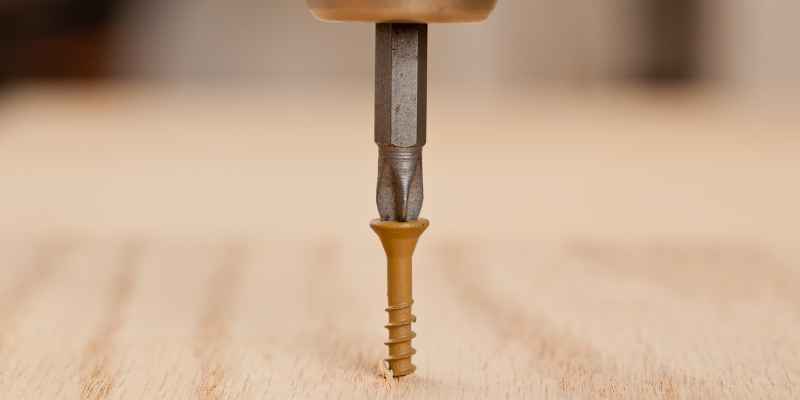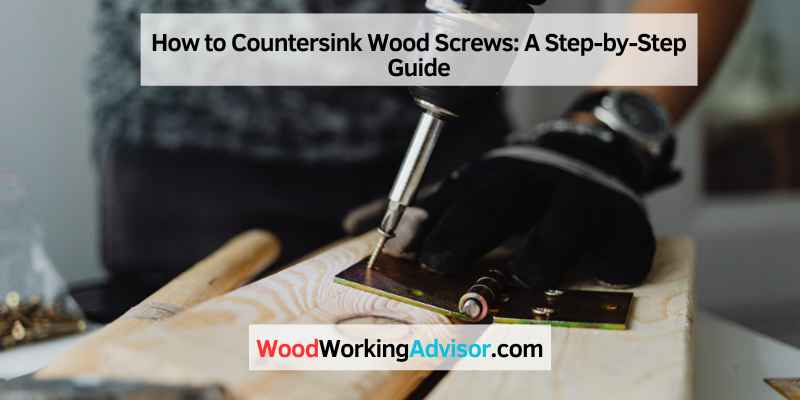To countersink wood screws, drill a pilot hole with a slightly larger bit than the screw’s head, then drill a shallow, wider hole to accommodate the head flush with the surface. Countersinking ensures a smooth finish and secure attachment of the screw in wood projects.
By following these simple steps, you can achieve professional-looking results and enhance the durability of your woodworking projects. Whether you are a DIY enthusiast or a seasoned woodworker, mastering the art of countersinking wood screws is essential for creating sturdy and aesthetically pleasing furniture, cabinets, or other wood constructions.
With proper technique and the right tools, you can easily achieve clean and flush screw installations that will elevate the overall quality of your woodworking projects.
Methods For Countersinking Wood Screws
To countersink wood screws, start by drilling a pilot hole, then use a countersink bit to create a shallow recess for the screw head. Adjust the countersink bit size accordingly for a perfect fit before driving the screw into the wood securely.
Countersink Drill Bit Method
For countersinking wood screws, the recommended method is to use a specialized countersink drill bit. This bit is designed to create a conical-shaped hole that allows the screw head to sit flush with the surface of the wood.
Regular Drill Bit Version
Alternatively, you can achieve a countersink by using a regular drill bit. Simply drill a pilot hole for the screw, then enlarge the hole slightly to create a countersink that accommodates the screw head.
Drilling Pilot Holes
- Start by drilling pilot holes for the screws to ensure accurate placement.
- Use a drill bit that is slightly smaller than the diameter of the screw to create these pilot holes.
Drilling The Countersink Hole
- After drilling the pilot holes, switch to a countersink drill bit or enlarge the hole to create a countersink.
- Ensure the countersink is deep enough for the screw head to sit flush with the wood surface.
Cleaning Up The Hole
Once the countersink is created, remove any wood debris or burrs to ensure a clean fit for the screw head.
Swap Batteries And Countersink Second Hole
When countersinking multiple screws, swap to fresh batteries if needed and repeat the process for each additional hole for a professional finish.
Alternative Techniques For Countersinking Screws
When it comes to woodworking, countersinking screws is a crucial technique that not only enhances the aesthetic appeal of your projects but also ensures a smooth, flush surface. While using a standard countersink bit is the most common approach, there are alternative techniques that can be just as effective. Let’s explore these alternative methods for countersinking screws.
Using A Sharp Chisel Or Carving Knife
If you don’t have a countersink bit on hand, a sharp chisel or a carving knife can be used as an alternative. Simply insert the corner of the chisel or knife into the pilot hole and gently twist it until the desired countersink is achieved. This method requires precision and control, but it can yield satisfactory results, especially for smaller woodworking projects.
Drilling A Slightly Larger Hole
An effective alternative to a countersink bit is drilling a slightly larger hole where the screw head will sit. By using a drill bit that is larger than the screw head, you can create a recess that allows the screw to sit flush with the wood surface. This method works well for softer woods and can be a quick solution when a countersink bit is not available.
Improvised Countersinking Methods
In certain situations, improvised methods such as using a hand file or sandpaper to create a countersink may be necessary. While these techniques may require additional time and effort, they can be viable options when traditional countersinking tools are not accessible.
Tips And Tricks For Successful Countersinking
Looking for tips and tricks on how to countersink wood screws? Check out these helpful tutorials on YouTube that provide step-by-step instructions and alternative methods for achieving a clean and successful countersink without the need for a specific countersink bit.
Increase your woodworking skills today!
Maintaining A Straight And Perpendicular Drilling Angle
To achieve a professional countersink, maintain a steady hand and ensure the drill is held straight and perpendicular to the wood surface. This prevents the screw head from sitting unevenly, ensuring a clean and flush finish. Utilize a drill press or a guide if necessary to maintain precision.
Starting The Drill At A Faster Speed
Initiate the drill at a faster speed to create a smoother initial cut. This technique minimizes the chances of splintering and enhances the overall result. However, as the drill bit begins to penetrate the material, reduce the speed to prevent any potential damage to the wood.
Checking And Adjusting Countersink Depth
Regularly check the depth of the countersink hole using a depth stop on the drill. This ensures consistency across all screws and prevents over or under-countersinking. If necessary, adjust the drill or countersink bit to achieve the desired depth, making small incremental changes until the perfect depth is reached.

Frequently Asked Questions On How To Countersink Wood Screws
How Do You Countersink A Screw Without A Countersink Bit?
To countersink a screw without a countersink bit, you can drill a pilot hole and then use a slightly larger drill bit to create a hole where the screw head will sit. Another option is to insert the corner of a sharp chisel or a carving knife into the pilot hole and twist it to create the countersink you need.
Do You Drill Or Countersink First?
First drill the pilot hole, then countersink to allow the screw to sit flush with the surface.
How Do You Countersink Bolts In Wood?
To countersink bolts in wood, drill a pilot hole using a slightly smaller bit than the bolt diameter. Then, drill a larger hole at the top to create a countersink for the bolt head. Use a countersink bit or a sharp chisel to create a clean, angled recess for the bolt head to sit flush with the wood surface.
What Is The Countersink Angle For Wood Screws?
The countersink angle for wood screws is commonly around 82 degrees.
Conclusion
Countersinking wood screws is crucial for a professional finish. By following the right steps and using the correct tools, you can achieve a clean and flush outcome. Practice makes perfect, so don’t get discouraged if it takes a few tries to master this skill.
Remember to prioritize safety and precision.


